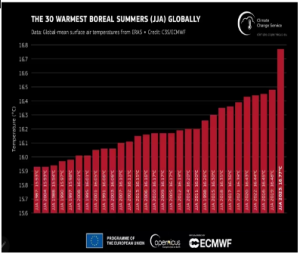Context:
- The continuous breaking of climate records related to temperature, ocean heat, and Antarctic sea ice provides strong evidence that the climate crisis has become a reality.
Climate records broken in the summer of 2023:
- Hottest summer ever: As per the World Meteorological Organization (WMO), this summer has been the hottest on record.
- During the three-month span from June to August, the average temperature reached 16.77 degrees Celsius, surpassing previous records by 0.66 degrees Celsius compared to the 1990-2020 average.
World Meteorological Organization (WMO):
- The WMO is a specialized agency of the United Nations responsible for promoting international cooperation on atmospheric science, climatology, hydrology and geophysics.
- Headquarters: Geneva, Switzerland
|
- Concerns:
 With rising temperatures and the onset of El Nino conditions, 2023 is potentially becoming the warmest year in history.
With rising temperatures and the onset of El Nino conditions, 2023 is potentially becoming the warmest year in history.- Currently, it ranks as the second-hottest year on record, a mere 0.01 degree Celsius away from surpassing the previous high of 2016.
- This emphasizes the concerning possibility of the Earth warming by 1.5 degrees Celsius compared to pre-industrial times.
- With this, it could result in irreversible damage to the planet’s ecosystem, with severe repercussions for both humans and other living organisms.
- Highest sea surface temperature: The global average sea surface temperature has reached unprecedented levels.
- In the period from July 31 to August 31, 2023, each day surpassed the previous record set in March 2016 in terms of warmth.
- Concerns: The oceans have absorbed 90% of the additional heat caused by human activity since the second half of the 19th Century. Higher ocean temperatures often cause marine heat waves (MHWs), which are extreme weather events.
- MHWs lead to the deaths of several marine species, alter their migration patterns, cause coral bleaching and even impact weather patterns. They also can make storms like Hurricanes and Typhoons stronger.
- Lowest Antarctic sea ice extent: According to a report from NASA’s Earth Observatory, in July of 2023, the Antarctic sea ice extent reached its lowest point since satellite records began in late 1978, with an average of 13.5 million square kilometers, marking a new record low for this time of the year.

- Concerns: The decline in sea ice coverage can result in elevated ocean temperatures, hinder ice formation, contribute to sea level rise, and disrupt ocean circulation patterns, raising alarm among researchers.
News Source: Indian Express
![]() 9 Sep 2023
9 Sep 2023
 With rising temperatures and the onset of El Nino conditions, 2023 is potentially becoming the warmest year in history.
With rising temperatures and the onset of El Nino conditions, 2023 is potentially becoming the warmest year in history.